Charles Phillip Spencer
b. 1802 - Camberwell, Surrey, UK or Kimpton, Hampshire, England
d. 1872, 13 December - Serpentine, WA aged 69-70
Buried Serpentine Cemetery, Jarrahdale, Western Australia
Married Elizabeth Weston Married 30 Sep 1828 @ St. Andrews Church, Holborn, Camberwell, London, England.
Children Elizabeth Spencer b 1826 , John Spencer, Mary Finch Spencer, Joshua Spencer, Ellen Amelia Spencer, Rhodia Rhoda Spencer, Emily Spencer, Mary Spencer, Charles Spencer, Alice Spencer
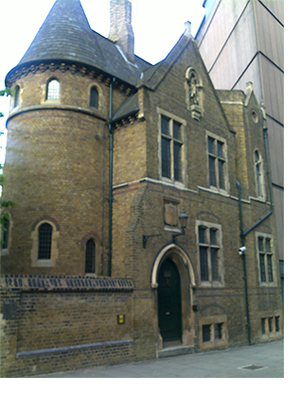 Picture here St. Andrews Church, Holborn, Camberwell, London, England.
Picture here St. Andrews Church, Holborn, Camberwell, London, England.
The Marriage of Charles and Elizabeth
Charles was born in 1802 or 1807 Essex and Elizabeth was born in 1800 on Hale Street, Kent. They married on the 30 Sep 1828 at St. Andrews Church, Holborn, Camberwell, London, England. They came to Western Australia on the 'Calista' arriving 5.August.1829 as one of the first families in the new colony.
Article compiled by Unice Duncanson, August 1979, also a direct descendant of Charles Phillip Spencer.
"The Barque 'Calista' weighing 320 tons and mastered by Capt. S. Hawkins left Portsmouth on the 5th March, 1829, bound for the Swan River. She carried 73 passengers, amongst them a party of settlers recruited by a certain Col. Latour, late of the 11th Dragoons. All were hungry for land but Col. Latour's scheme, similar to Thomas Peel's on a smaller scale, also failed and later his confused financial affairs and "disingenuous dealings" were the subject of a legal inquiry in London, and he was held in the King's Bench Prison.
Also amongst the passengers was merchant Lionel Samson and his brother William, also Charles Spencer and Thomas Finnegan, two employees of Lionel who were bound by indenture, possibly before they left England.
Charles Spencer brought with him, his wife Elizabeth who was expecting a child, and 4 year old daughter, Elizabeth. The fare for a young man, his wife and child at this time would have been about £120.
On arrival in Rio de Janeiro the ship was in a 'dreadful state' with the passengers complaining of an inadequate supply of provisions and they forthwith made presentation to the Ambassador, Lord Ponsonby, who immediately adjusted the matter, ensuring that a regular treaty was drawn up for a daily supply, both for cuddy and steerage passengers. Mismanagement aboard had also been responsible for heavy stock losses.
The 'Calista' was not far behind the 'Parmelia' in the race for the Swan River Colony and arrived in Cockburn Sound on 5th August, 1829 exactly 5 months after setting sail from England.
The Callister Passenger List
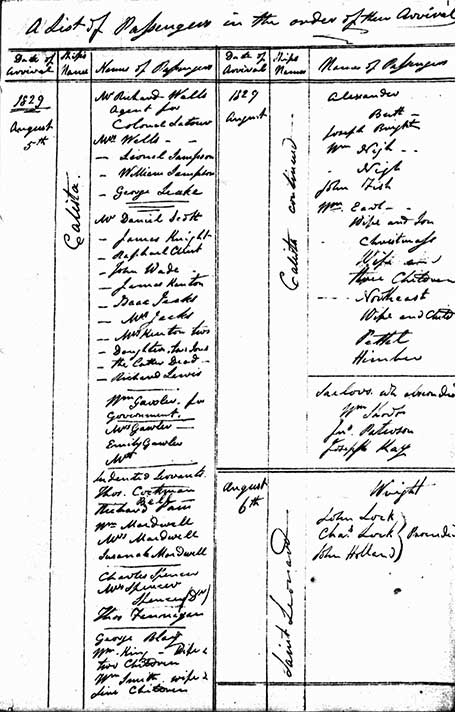 It must have been a great shock to all on board to see the inhospitable coastline and find absolutely no preparation for their arrival or accommodation, contrary to the high promises made in early advertisements in the English newspapers. Other ships also started arriving and Capt. Stirling was hard pressed to get them all housed into even the most temporary of shelters.
It must have been a great shock to all on board to see the inhospitable coastline and find absolutely no preparation for their arrival or accommodation, contrary to the high promises made in early advertisements in the English newspapers. Other ships also started arriving and Capt. Stirling was hard pressed to get them all housed into even the most temporary of shelters.
A hastily pitched tent would have been Charles' and Elizabeth's first 'home' and here they must have sheltered little Elizabeth and 9 day old John until their first house was built on lot 299, The Cantonment, Fremantle.
Charles worked for 2 years for Samson, helping him establish his first business. On 28th February, 1831, Lionel Samson cancelled the indentures of Spencer and Finnegan.
About this time Charles moved to Red Cliff Farm on the Canning River, in the employ of Capt. Thomas Hester. Shortly after this Capt. Hester sold 209 acres of his land, with river frontage, to two gentlemen of doubtful characters by the names of Thomas Worrell and William Booker. Both these men were sentenced to prison terms - Booker actually escaped from goal and absconded - and probably by default and in lieu of wages Hester made the land over to Charles and Elizabeth to hold in trusteeship until their minor children Elizabeth jnr. and John, reached the age of 21 years.
Title was not recognized until several years later.
Charles and Elizabeth had seven more children in the house they built near the river, and they farmed the property until they decided to move to the Serpentine in 1852. John remained behind (Elizabeth jnr. was now Mrs. James Gallop) and he built his homestead near where the great English oak now stands.
Charles died at the Serpentine in 1872 and Elizabeth snr. eventually moved back to the Canning and died in John's house in 1884. John owned the property until his death in 1910. ".
On 30/5/1833 Charles applied to join the yeomanry guard to act against the natives.
He was mentioned in the 1837 census as a Farmer in the Canning district. Daughter Elizabeth worked in the Canning district as a servant. In August 1841 his wife Elizabeth lost the Fremantle lot 83, due to non payment of location dues (1). In October 1844 found a filly on his Farm at Canning. In September 1850 advertised for strayed stock (1).
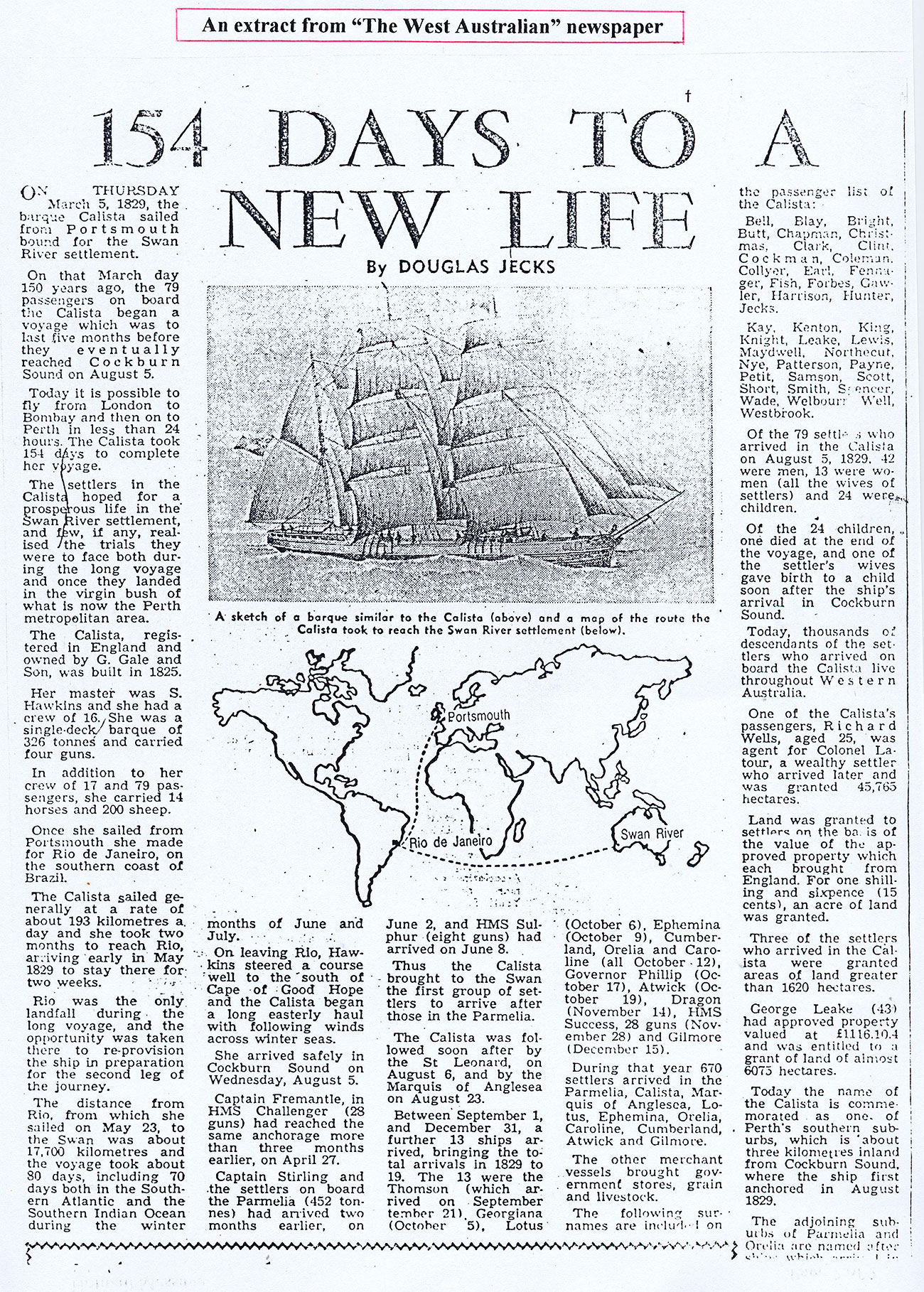
Charles Philip Spencer b c 1802/5 in Camberwell Essex England arrived on the Calista 5/08/1829 with wife Elizabeth nee West and Children Elizabeth b 1825 in Camberwell and John born at Sea 27/07/1829 .. they had 7 more children after arriving in the colony.
Mary Finch born 1831 died in 1833
Joshua b 1833
Rhodia b 1837
Emily b 1839
Mary b 1840
Charles b 1842
Alice b 1845
The first home Charles and Elizabeth had in the Colony was a tent. Charles was indentured to merchant Lionel Samson until 28 February 1831 when the Indenture was released. They lived in Cantonment Street, Fremantle during that period. Charles then worked for Captain Thomas Hester on Red Cliff Farm at Canning River. Charles proved to be dependable, self reliant and with previous farming experience. Together the couple turned very marginal farming land into a reasonable successful operation. In lieu of wages, Hester made over some land to Charles and Elizabeth to hold in trusteeship for their children, Elizabeth and John reached the age of twenty one. They farmed this land until they moved to Serpentine in 1852. Charles was granted 25 acres and Lot 48 of 10 acres. These lots were located on the Serpentine River about one mile from the Falls. In this time they had seven more children. After they left, John continued to work the Canning River property until his death in 1910. Spencer Road in Thornlie is named after the family and Oak Tree Court, Langford is the location of an oak tree planted on the original farm. The family with seven of the children built a thatched roofed cottage. Charles became Postmaster of Serpentine until his death at Serpentine on 13 December 1872. His wife Elizabeth died 5 January 1884 at her son John's house at Canning River. Elizabeth is buried in the old Kenwick cemetery (Gosnells). Elizabeth Spencer married James Gallop, John Spencer married Jane Hannah Willey, Joshua married Mary Anne Moore, Rhodia married Walter Scrivener and Emily married John Richard Pengelly.
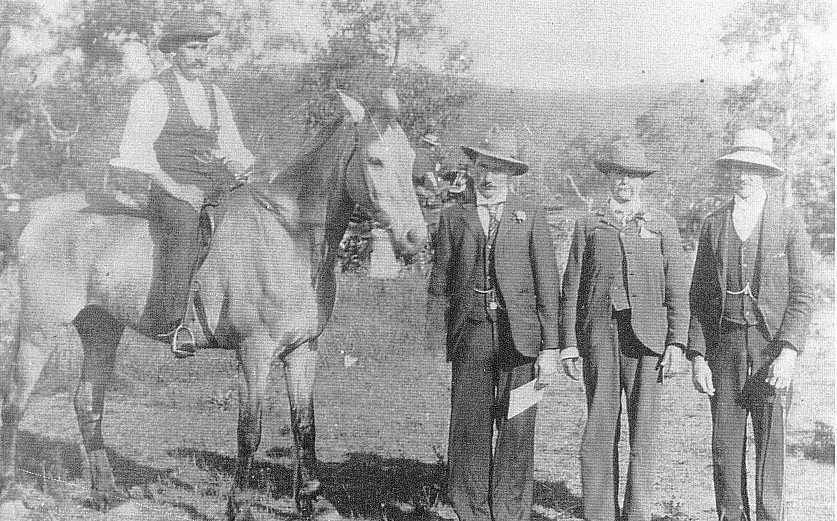
Charles on a horse, his brother holding the horse
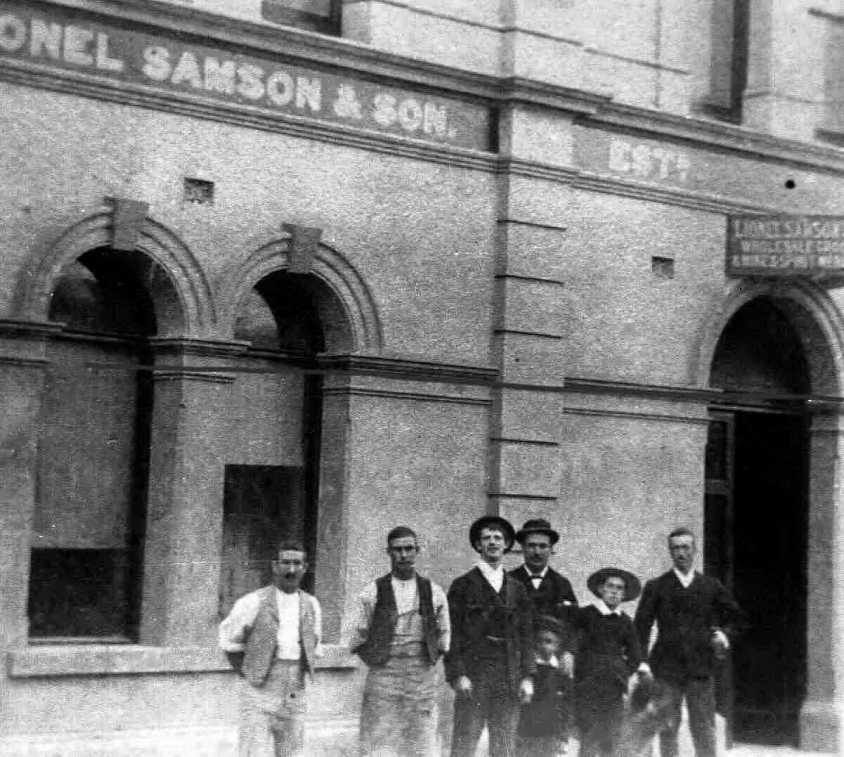
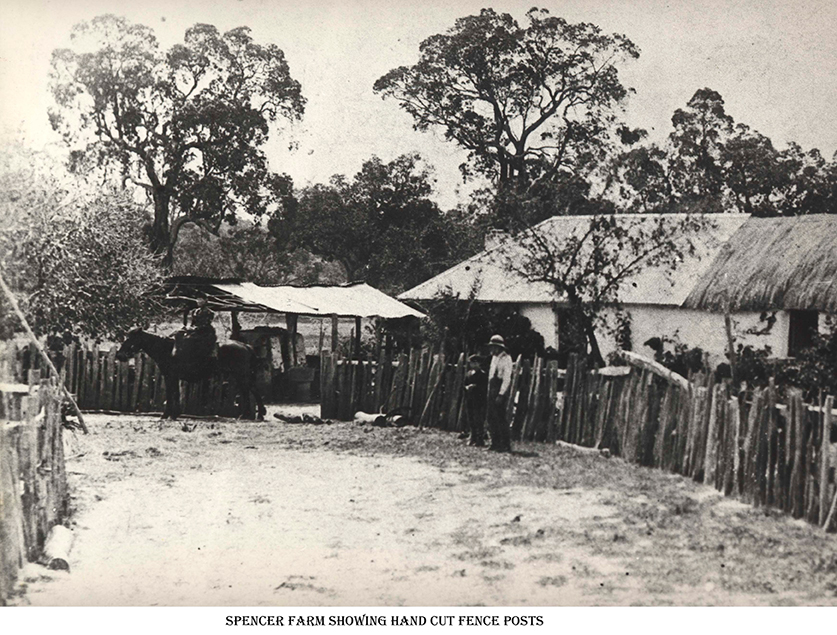
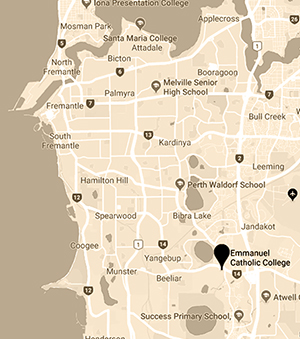
Emmanuel Catholic College site of the Spencer Family Farm and Mulberry Tree planted by Charles and his wife.
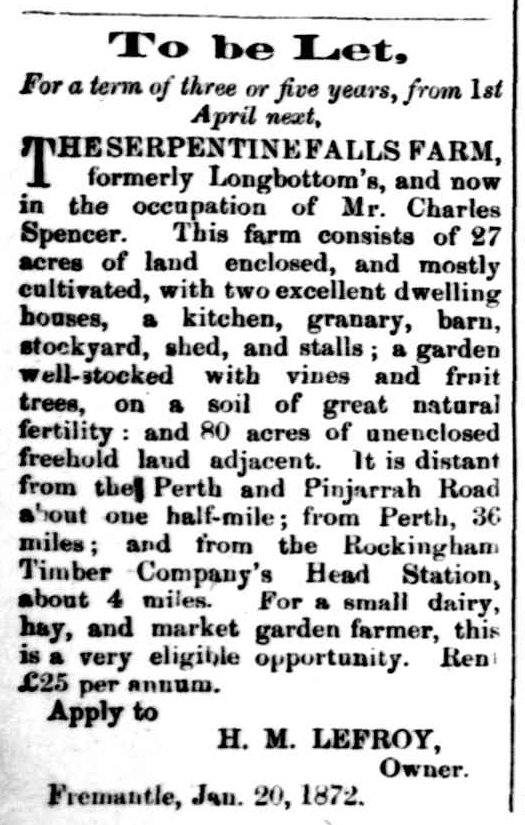
Charles is also mentioned in "The Serpentine" by Neil J. Coy 1979.
pp.54-55 "THE SPENCER FAMILY began their long association with Serpentine when the 10 hectare Co. Sd. 39 was surveyed in September 1852. This block is situated on the south bank of the river directly opposite Serpentine Falls Farm. Charles Phillip Spencer (1802-07-1872), who had married Elizabeth Weston in 1824, built a thatched roof cottage on this location for their 8 children. The Spencers', who came from Essex, were very early Colonials who disembarked from the Calista in August, 1829. Charles was indentured to Lionel Samson, the Fremantle Merchant, with whom he worked until 1832. They then moved to Capt. Thomas Hester's Red Cliff Farm (at Langford), where they stayed for the next 20 years. In 1845 their 2nd son, Joshua, had a narrow escape from death when a group of Aboriginals were on hand to extract the venom from a snake bite. Family legend recalls the incisions being cut longitudinally along the limb to avoid the severing of sinews. Joshua was later renowned for his vexed attitude towards snakes.
Charles Spencer's first pastoral lease was taken out with his neighbour, Benjamin Baldwin, and Joshua Spencer held a temporary lease of 2.000 hectares which he allowed to lapse in 1854. In later years Joshua took up land in Serpentine Gorge and also formed an alliance with the Tonkin family. Charles's great grandson, Vivian Spencer (1905-1983), ran sheep and grew cauliflowers in the hills for many years."
Charles was one of 11 men who signed a paper emphasizing their deeply religious convictions. It went as follows:"
pp63-64 "We the under signed, being the Fathers or other National Guardians of the children in the Serpentine and
Mundajil Schools re present to your Excellency with deep respect;
1. That we are without exception Protestants;
2. That we are unanimous in our conviction that the exclusion of the Bible from Government Schools is a like derogation to the Supreme Being, and prejudicial to the interests of our children.
3. And without one dissentient we are, further, unanimous in requesting that its free and unrestricted use - save as a Class Book - may be conceded to us.
Your memorialists will ever prayeth.
S. Longbottom, John Fairbairn, Charles Spencer, B. Baldin (sic) Baldwin, Joseph Batt, W.J.Gibbs, John Giblett, James Crassey, Thomas Brown, W.Mead.
pp 66 " In 1860 the Serpentine Bridge School doubled as the local Post Office when schoolmaster John Fairbairn also took on the responsibility of Postmaster. Then between Dec, 1863-1866, the mailman (Sam Lazenby delivered the mail on horse-back in 1865) side-tracked the Serpentine Falls Farm while Steven Longbottom held the contract. In Jan, 1866, Edward Turner was Postmaster for a fortnight after which the Spencer family maintained the contract between 1866-1874 when the position was gazetted under the name of Charles Spencer, even after his death in 1872. As Spencer's cottage was, like Longbottom's, somewhat east of the road, another deviation would have been needed to pick up the mail, which had been upgraded to a twice-weekly service in 1867. Reference to this situation was made by John Wellard's correspondence in 1870, which also mentions an unsuccessful request for a Police Constable to be stationed at Serpentine Bridge:
Extracted from the Biographical File for Spencer, Gosnells Public Library.
LOCATION 19
Memorial: 200 acres of land adjoining Red Cliff Farm on the Canning River lately purchased by the said Thomas Worral of Captain Hester. Object of memorial - to give two Fremantle allotments and 200 acres of Canning land to John and Elizabeth Spencer, children of Charles and Elizabeth Spencer, for their sole use forever. Charles and Elizabeth trustees until children are 21.
The Last Will and Testament of Charles Phillip Spencer
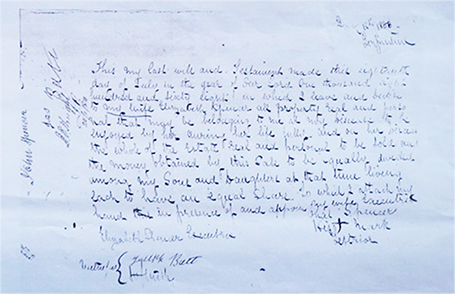 This my last will and testament made this eighteenth day of July in the year of our Lord One thousand eight hundred and sixty eight in which I leave and bequeath to my wife Elizabeth Spencer all property real and personal that may be belonging to me at my decease to be enjoyed by her during her life fully and on her decease the whole of the estate real and personal to be sold and the money obtained by this sale to be equally divided among my sons and daughters at that time living. Each to have an equal share to which I attach my hand in presence of and appoint my wife executor.
This my last will and testament made this eighteenth day of July in the year of our Lord One thousand eight hundred and sixty eight in which I leave and bequeath to my wife Elizabeth Spencer all property real and personal that may be belonging to me at my decease to be enjoyed by her during her life fully and on her decease the whole of the estate real and personal to be sold and the money obtained by this sale to be equally divided among my sons and daughters at that time living. Each to have an equal share to which I attach my hand in presence of and appoint my wife executor.
Charles Spencer.
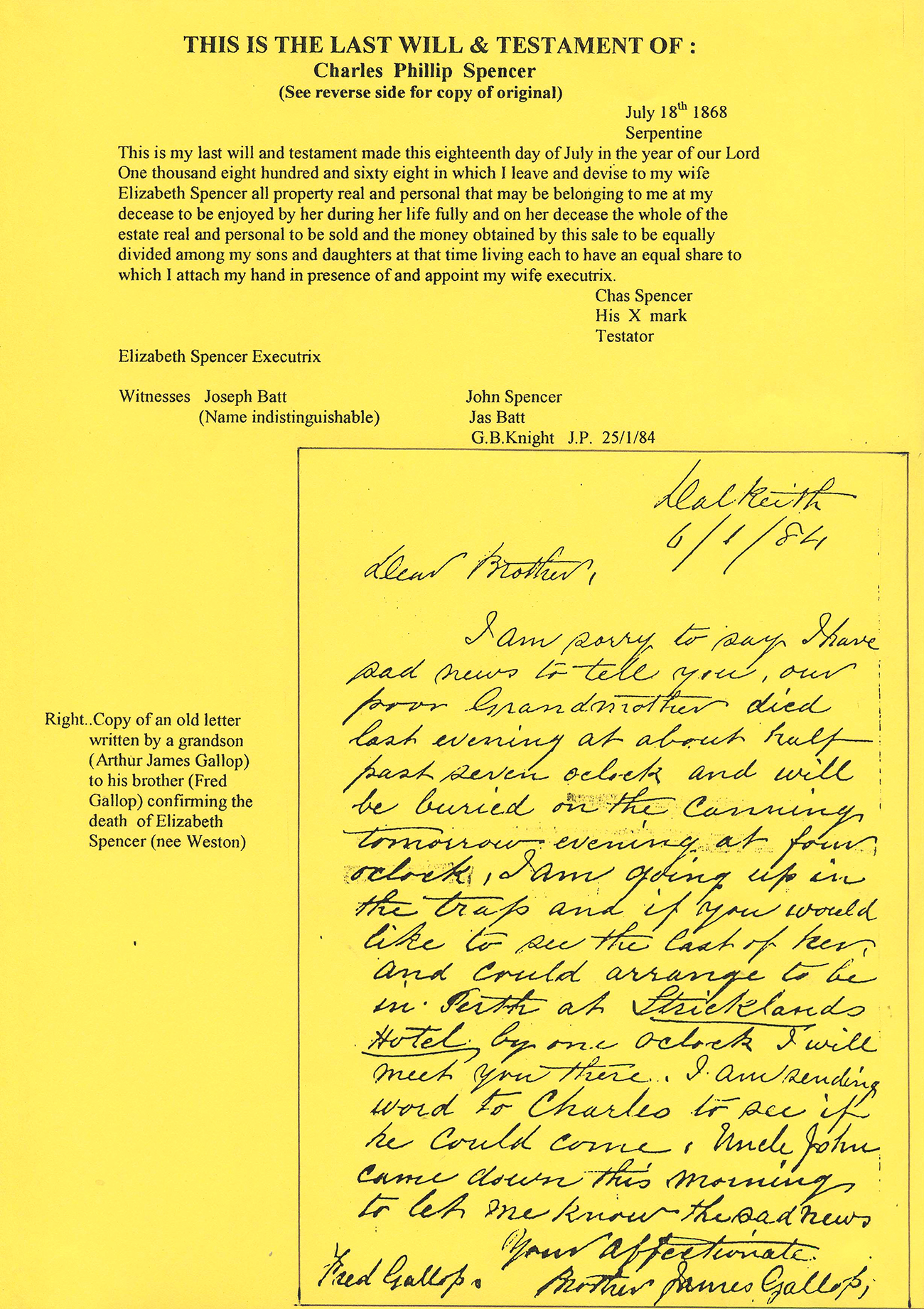
Hi, I am interested to hear from anyone with information on my GGG Grandfather, Charles Phillip Spencer and his wife Elizabeth (nee WESTON). We believe Charles was born in 1802 or 1807 Essex and Elizabeth 1800 Hale Street, Kent. They married in 1824 in Camberwell, London, England and came to Western Australia on the 'Calista' arriving 5.August.1829 as one of the first families in the new colony.
As yet no one as been able to find out anything about their parentage. Some members of the Spencer clan in Oz have a story that Charles was born Charles Phillip Churchill-Spencer, son of a wealthy land owner who disowned and disinherited him when he married Elizabeth. I have never been able to find any proof of this and am rather sceptical as it seems to be rather fanciful considering Charles signed his last Will & Testament with a X. Had he been the son of a wealthy family, surely he would have been educated enough to have been able to sign his own name.
Charles and Elizabeth went on to have nine children, 7 of whom survived and married. The eldest daughter, Elizabeth, born 1824 in Essex married James GALLOP, forbearer of today's Western Australian Premier, Jeff Gallop.
Their next child, my GG Grandfather, John born 1829, said to be the first white male child born in the colony, married Jane Hannah WILLEY.
J BICKMORE
South Australia
To read more about the early day of the Swan River Settlement click here.
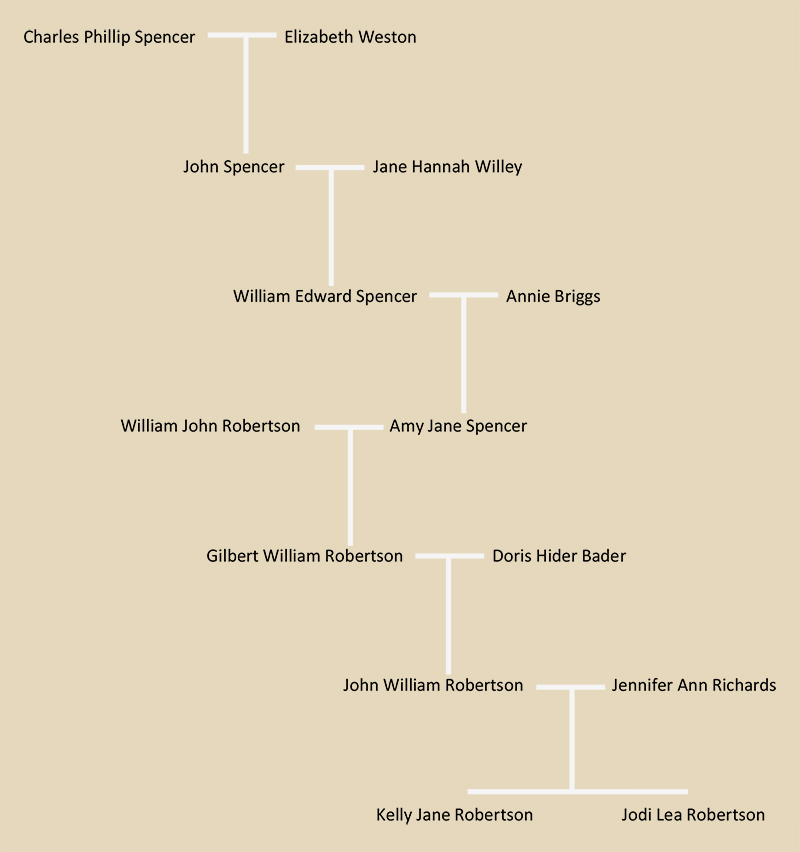
*If a Family Tree image has that it is linked to interactive PDF, once the Family Tree image is clicked it will open a PDF you can then click on either the names or faces to go to that relatives page.
*Names throughout the site that are coloured blue are linked to that persons page.
